“Alexa, how do you protect my privacy?” A quantitative study of user preferences and requirements about smart speaker privacy settings
IF 4.8
2区 计算机科学
Q1 COMPUTER SCIENCE, INFORMATION SYSTEMS
引用次数: 0
Abstract
Voice assistants are becoming increasingly popular. While users may benefit from the convenience of voice interactions, the use of voice assistants raises privacy issues. To address them, existing voice assistants propose some privacy settings. However, we are lacking knowledge about (1) which privacy settings are important to users, (2) what are their preferences about their application, and (3) what are their requirements beyond existing privacy settings. Gaining such knowledge is important to understand why users may not use these settings and to identify which settings should be introduced to allow users to better protect their privacy. To this end, we have conducted a quantitative online study with 1,103 German smart speaker owners. Detailed insights are provided into how beliefs about data handling practices, usage of existing privacy settings, affinity for technology interaction, and privacy attitudes vary depending on the brand of smart speakers used by participants. These findings reveal discrepancies in user trust and preferences across different manufacturers. Additionally, statistical evaluations, including effect size calculations, are introduced, alongside expanded results with detailed explanations to enhance the contextual understanding of the findings. The study provides recommendations for manufacturers and policymakers to improve transparency, usability, and education on privacy settings. Practical guidelines for privacy-preserving features are included, advancing understanding of user needs and aiding in the design of better solutions. In addition to partly replicating findings obtained with different samples, the results show that the currently available privacy settings do not fully cover user requirements and indicate a general desire for more transparency and control over the collected data. Our results hence serve as basis for designing future privacy-preserving solutions.
求助全文
约1分钟内获得全文
求助全文
来源期刊

Computers & Security
工程技术-计算机:信息系统
CiteScore
12.40
自引率
7.10%
发文量
365
审稿时长
10.7 months
期刊介绍:
Computers & Security is the most respected technical journal in the IT security field. With its high-profile editorial board and informative regular features and columns, the journal is essential reading for IT security professionals around the world.
Computers & Security provides you with a unique blend of leading edge research and sound practical management advice. It is aimed at the professional involved with computer security, audit, control and data integrity in all sectors - industry, commerce and academia. Recognized worldwide as THE primary source of reference for applied research and technical expertise it is your first step to fully secure systems.
 求助内容:
求助内容: 应助结果提醒方式:
应助结果提醒方式:


